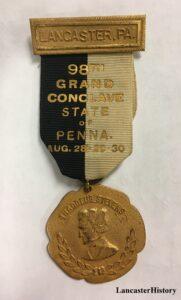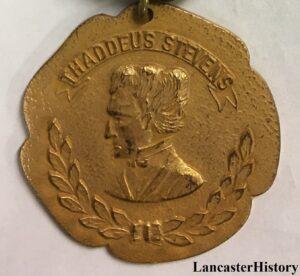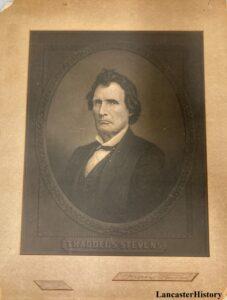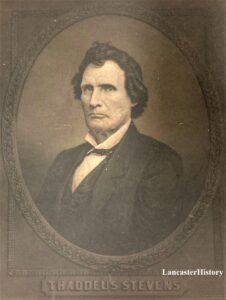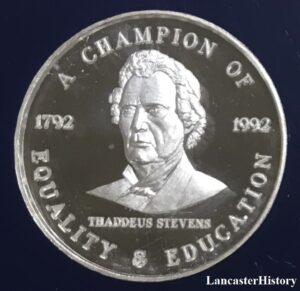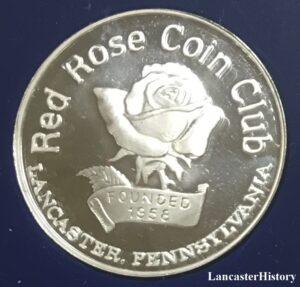Thaddeus Stevens and the Mystery of the Masonic Medal
The Great Commoner
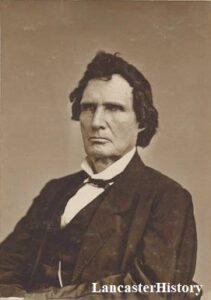
As a champion of racial and social equality in America as well as the free public school system in Pennsylvania, it should come as no surprise that Thaddeus Stevens (1792-1868) was also vehemently opposed to exclusionary organizations and secret societies. He regarded such groups as elitist and a peril to democracy. Stevens was especially troubled by what he saw as the exaggerated influence of Freemasonry in politics. A successful attorney in Gettysburg, Stevens first entered politics in 1822 as an elected member of Gettysburg Borough Council. In 1832 he won election to the state House of Representatives as a member of the Anti-Masonic Party. He would serve in the state legislature until 1841 before moving to Lancaster in 1842.
In Lancaster, Stevens became a member of the Whig Party, serving in the U.S. House of Representatives from 1848 until 1853. Following the demise of the Whig party, he joined the newly formed Republican Party and was again elected to Congress in 1858. Stevens served in Congress until his death in 1868. During this tenure he led the fight for passage of the 13th and 14th Amendments to the U.S. Constitution; amendments that abolished slavery and guaranteed citizenship and equal protection under the law to people of African descent born in this country.
Remembering Thaddeus Stevens
Because of Stevens’ opposition to Freemasonry, imagine our surprise at discovering a Masonic medal featuring the likeness of Thaddeus Stevens in our collection! While the mention of a Grand Conclave gave us some idea of the medal’s origin, we were unsure of when the event was held since the attached ribbon did not include a year. Fortunately, our own records coupled with information provided by Nathaniel Gilchrist, historian and curator of Masonic Lodge 43 in Lancaster, allowed us to piece together the circumstances surrounding production of the medal for the Grand Conclave.
Our own catalog records showed that the medal and attached ribbon came to what was then the Lancaster County Historical Society in 1930 – but as two different donations. George Erisman (1863-1961), a local expert on dolls and owner of Lancaster’s own “doll hospital” as well as one of Lancaster’s leading costumers, donated the ribbon. Interestingly, the ribbon seems to have been manufactured by Erisman’s company—a tag on the inside of the ribbon reads “Erisman Kostumer, Mason Costume and Theatrical Supply, Geo. K. Erisman.” Although the medal and ribbon apparently go together, the medal came to the historical society as a separate donation. The medal donation was made by Alice Malone (1883-1958), a local artist who attended the School of Industrial Art in Philadelphia. Although we cannot say for certain who crafted this likeness of Stevens, it seems likely that Malone was the designer as well as the donor of the medal.
An article that appeared in the Intelligencer Journal on Saturday, August 30, 1930 provided an important clue as to why this Grand Conclave chose to honor Stevens. The article included the subheading “Installation of New Officials Marks End of Convention Here” and contained the following text:
John Washington, of Philadelphia, was elected right eminent grand commander of the grand commandery, Knights Templar of Pennsylvania, Prince Hall affiliation, at the annual election of officers that featured the closing of the 98th annual conclave in this city on Friday.
About 250 persons, including Sir Knights and members of the Ladies’ auxiliary, participated in the parade during the afternoon. Stopping at Shreiner’s cemetery, West Chestnut and Mulberry streets, the officers placed two floral wreaths on the grave of Thaddeus Stevens.
The mention of “Prince Hall affiliation” in the above quote is especially telling. Despite Stevens’ opposition to Freemasonry, the Prince Hall Masons felt a special connection to Stevens. Prince Hall, founder of this branch of Freemasonry, was an abolitionist and leader in the free Black community of eighteenth century Boston. Those who assembled in Lancaster for this particular Grand Conclave assembled, in part, to honor Stevens’ contributions to combating racism and promoting social justice. Today, the Most Worshipful Prince Hall Grand Lodge of Pennsylvania, consists of three subordinate lodges; an Eastern Region based in Philadelphia, a Central Region based in Harrisburg, and a Western Region based in Pittsburgh.
Images of Thaddeus Stevens
The inspiration for the left-facing profile of Thaddeus Stevens above a laurel wreath is unknown. One of the most widely recognized images of Stevens is taken from the 1862 straight-facing photograph taken by Lancaster photographer Charles W. Eberman included at the beginning of this blog. That image has been reproduced a number of times, including as an 1867 mezzotint steel engraving by printmaker John Sartain of Philadelphia and an 1899 engraving by Robert Laughlin Rae, published by J.P. McCaskey of Lancaster. One of more recent examples of this likeness appeared on a 1992 Red Rose Club Medal honoring the bicentennial of Stevens’ birth; an image appropriately and succinctly surrounded by the words “A Champion of Equality and Education.”
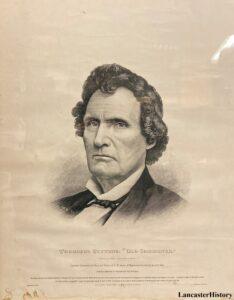
From Object Lessons

